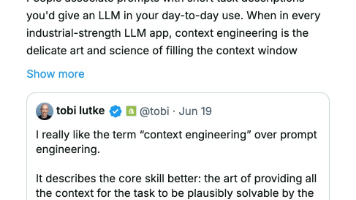前端基于 TypeScript 使用 Mastra 来开发一个 AI 应用 / AI 代理(Agent)
下面给出一份“从 0 到 1”的完整路线,演示如何(Node 20 + npm + VSCode)借助快速落地一个可对话、可调用工具、具备记忆与知识库的。全部代码均为,无需切 Python,也无需自己拼 OpenAI SDK。
·
下面给出一份“从 0 到 1”的完整路线,演示如何用前端熟悉的 TypeScript 技术栈(Node 20 + npm + VSCode)借助 Mastra 快速落地一个可对话、可调用工具、具备记忆与知识库的 AI 代理(Agent)。全部代码均为纯 TypeScript,无需切 Python,也无需自己拼 OpenAI SDK。
1.环境准备(3 分钟)
① 安装 Node ≥ 20
② 拿到任意 LLM 密钥(下面以 OpenAI 为例)
③ 一键脚手架
npm create mastra@latest my-agent # 按提示选 Agent + RAG + Workflow
cd my-agent
npm install④ 把密钥写进根目录.env
OPENAI_API_KEY=sk-xxxxxxxx2.目录速览(官方约定 > 配置)
src/
├─ mastra/
│ ├─ index.ts // 框架入口,注册 Agent/Workflow
│ ├─ agents/
│ ├─ tools/ // 自定义工具(函数 + Zod Schema)
│ ├─ workflows/ // 图状工作流
│ └─ memory/ // 可选:向量库配置(pgvector / Pinecone …)
└─ index.ts // 你的业务脚本 / API 路由所有.ts文件在npm run dev时会被tsx实时转译,前端同学零学习成本。
3.第一步:写一只“会查天气”的 Agent
- 在
src/mastra/tools/weather.ts里声明“工具”
import { createTool } from '@mastra/core';
import { z } from 'zod';
export const weatherTool = createTool({
id: 'get_weather',
description: '查询城市当前气温',
inputSchema: z.object({ city: z.string() }),
outputSchema: z.object({ temp: z.number(), unit: z.string() }),
execute: async ({ city }) => {
// 这里调真实天气 API,示例直接 mock
return { temp: 26, unit: '°C' };
},
});- 在
src/mastra/agents/weatherAgent.ts里组装 Agent
import { Agent } from '@mastra/core';
import { openai } from '@ai-sdk/openai';
import { weatherTool } from '../tools/weather';
export const weatherAgent = new Agent({
name: 'weatherBot',
model: openai('gpt-4o'),
instructions: '你是天气小助手,可按用户要求查询实时气温。',
tools: { weatherTool },
});- 把 Agent 注册到框架
// src/mastra/index.ts
import { Mastra } from '@mastra/core';
import { weatherAgent } from './agents/weatherAgent';
export const mastra = new Mastra({
agents: { weatherBot: weatherAgent },
});4.第二步:本地调试 —— 官方 Playground
npm run dev # 默认拉起 http://localhost:4111浏览器里会出现类似 Vite 的 DevUI:
- 左侧直接对话,右侧可看 Agent 调用栈、工具参数、耗时。
- 修改
.ts文件保存即热更新,体验与前端开发一致。
5.第三步:把 Agent 嵌入你的前端/全栈项目
- 任何脚本里调用
// src/index.ts
import { mastra } from './mastra';
(async () => {
const agent = mastra.getAgent('weatherBot');
const reply = await agent.generate('上海现在多少度?');
console.log(reply.text); // 文字答复
console.log(reply.toolCalls); // 实际调了 weatherTool
})();- 或者作为 API 路由(以 Next.js 为例)
// app/api/chat/route.ts
import { mastra } from '@/mastra';
import { CoreMessage, streamText } from 'ai';
export async function POST(req: Request) {
const { messages }: { messages: CoreMessage[] } = await req.json();
const agent = mastra.getAgent('weatherBot');
const result = await streamText({ // 支持流式返回
model: agent.model,
messages,
tools: agent.tools,
});
return result.toDataStreamResponse();
}前端直接用 Vercel useChat 即可零胶水接入聊天界面。
6.第四步:给 Agent 加上“长期记忆 + 企业知识库”
- 启动向量库(本地实验可用 SQLite +
pgvector扩展,生产换 Pinecone) - 在
src/mastra/memory/新建rag.ts
import { PgVector } from '@mastra/vector-pgvector';
import { embedMany } from '@ai-sdk/openai';
export const rag = new PgVector({
connectionString: process.env.PG_CONN!,
embed: embedMany,
});3.把文档灌进去(一次 ETL)
await rag.upsert('kb001', [
{ text: '公司退货政策:7 天内无理由…', metadata: { url: '/policies' } },
]);4.在 Agent 里打开 knowledge 开关
new Agent({
name: 'supportBot',
model: openai('gpt-4o'),
knowledge: { rag, topK: 5 },
instructions: '你只能用知识库内容回答售后问题。',
});至此,Agent 回复将完全基于企业内部文档,并可标注引用段落。
7.第五步:让多步业务“可观测、可重试”—— Workflow
当流程需要“确定性”时(审批、报告、ETL),用 Workflow 而非让 Agent 自由发挥:
import { Workflow } from '@mastra/core';
export const refundWorkflow = new Workflow({
name: 'refund',
inputSchema: z.object({ orderId: z.string() }),
steps: [
{ id: 'checkOrder', run: async ({ input }) => { /* 查订单 */ } },
{ id: 'llmSummary', run: async ({ ctx }) => {
// 任意步骤都可再次调用 LLM
const agent = mastra.getAgent('supportBot');
return agent.generate(`请总结订单 ${ctx.input.orderId} 的退款原因`);
}},
{ id: 'approve', if: (ctx) => ctx.stepResults.llmSummary.score > 0.8,
run: async () => { /* 自动同意 */ } },
],
});Workflow 自带
- 可视化追踪(OpenTelemetry)
- 失败重试 / 人工审核(
.waitForEvent) - 子流程复用
8.构建 & 部署
npm run build # 生成 standalone 产物
npm start # 本地生产验证官方助手一键部署:
npx mastra deploy vercel # 或 cloudflare / netlify / docker生成的端点即标准 HTTP API,前端(React/Vue/Swift/Flutter)直接 fetch。
9.常见前端集成模式
| 场景 | 推荐做法 |
|---|---|
| Web 聊天框 | useChat(Vercel AI SDK)+ 上面 /api/chat 路由 |
| 小程序 | 把 streamText 换成 generateText,一次性返回 |
| 本地 Electron | 把 mastra 实例挂在主进程,渲染进程 IPC 调用 |
| SSR 站点 | 在 getServerSideProps 里预执行 Workflow,生成静态报告 |
10.小结
- Mastra = “TypeScript 版的 LangChain + Temporal”,但零配置、前端友好。
- 你只需:
- 写
tools(普通函数 + Zod) - 写
Agent(绑定模型、指令、工具、知识库) - 必要时写
Workflow(图状流程、可重试) - 开发体验完全等同于写前端:热更新、类型提示、可视化 Playground、一键部署。
照着上面 5 步走,30 分钟内即可拥有一个可对话、可查询天气、具备知识库与记忆、可上线部署的 AI 代理;后续继续叠工具、叠 Workflow、换模型即可快速演进。祝编码愉快!
更多推荐
 已为社区贡献3条内容
已为社区贡献3条内容








所有评论(0)